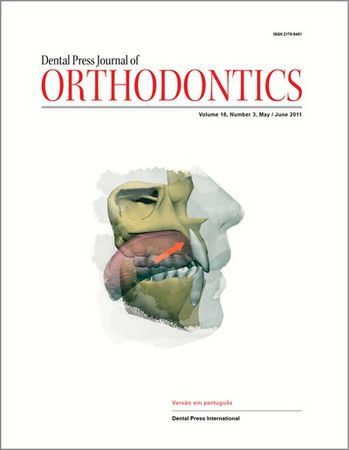Editorial Board
Autores:
messages.RevistaAutores: Corpo Editorial,
LEIA MAIS
Planning is necessary; running risks is not necessary
Along the many years dealing with topics in the frontiers of orthodontic possibilities, I have often answered questions about treatment risks. It started with the first lectures about skeletal anchorage about fifteen years ago, when concerned eyes paid — and still pay — attention to new...
Autores: Jorge Faber,
messages.RevistaAutores: editorial,
LEIA MAIS
Cephalometry is an important predictor of sleep-related breathing disorders in children
Sleep-related breathing disorders (SBD) have been studied and treated for a long time in adults, but little attention has been given to children, for whom SBD may be as serious as for adults. Parents, guardians and healthcare personnel should pay close attention to these problems, which may be...
Autores: Jorge Faber, Flávia Velasque,
messages.RevistaAutores:
LEIA MAIS
Indirect bone resorption in orthodontic movement: when does periodontal reorganization begin and how does it occur?
Tooth movement induced by orthodontic appliances is one of the most frequent therapeutic procedures in clinical dental practice. The search for esthetics and functionality, both oral and dental, demands orthodontic treatments, which are often associated with root resorptions that may, in extreme...
Autores: Alberto Consolaro, Leda Aparecida Francischone, Milton Santamaria Jr, Vanessa Bernardini Maldonado, Lysete Berriel Cardoso, Angela Mitie Otta Kinoshita, Ana Carolina Cuzuol Fracalossi,
messages.RevistaAutores:
LEIA MAIS
An interview with James A. McNamara Jr.
I met James A. McNamara Jr. in the late 70’s when we both became full members of the Edward H. Angle Society ofOrthodontists - Midwest. Jim is one of the most active members, always looking on to break boundaries with new works.During over 30 years, I saw him being presented with all the...
Autores: Weber Ursi, Bernardo Quiroga Souki, Carlos Alexandre Câmara, Roberto Mario Amaral Lima Filho, James A. McNamara Jr, Carlos Jorge Vogel, José Maurício de Barros Vieira,
messages.RevistaAutores: entrevista,
LEIA MAIS
Imaging from temporomandibular joint during orthodontic treatment: a systematic review
Introduction: The evolution of imaging in dentistry has provided several advantages for the diagnosis and development of treatment plans in various dental specialties. Examinations as nuclear magnetic resonance, computed tomography and cone beam volumetric tomography, as well as 3D reconstruction...
Autores: Eduardo Machado, Renésio Armindo Grehs, Paulo Afonso Cunali,
messages.RevistaAutores: orthodontics, Tomography, Temporomandibular joint disorders, Temporomandibular joint, Magnetic resonance imaging, Temporomandibular joint dysfunction syndrome,
LEIA MAIS
Cytotoxicity of electric spot welding: an in vitro study
Objective: The welding process involves metal ions capable of causing cell lysis. In viewof this fact, the aim of this study was to test the hypothesis that cytotoxicity is present indifferent types of alloys (CrNi, TMA, NiTi) commonly used in orthodontic practice whenthese alloys are subjected...
Autores: Matheus Melo Pithon, Lincoln Issamu Nojima, Antônio Carlos De Oliveira Ruellas, Rogério Lacerda Dos Santos, Leonard Euler A. G. Nascimento, Fernanda Otaviano Martins, Maria Teresa Villela Romanos, Matilde Da Cunha G. Nojima,
messages.RevistaAutores: Cell culture techniques, Toxicity, Welding in dentistry,
LEIA MAIS
In vitro study of shear bond strength in direct bonding of orthodontic molar tubes
Objective: Although direct bonding takes up less clinical time and ensures increased preservation of gingival health, the banding of molar teeth is still widespread nowadays. It would therefore be convenient to devise methods capable of increasing the efficiency of this procedure, notably for teeth...
Autores: Júlio De Araújo Gurgel, Arnaldo Pinzan, Fausto Silva Bramante, Célia Regina Maio Pinzan-Vercelino, Luciana Maio Pinzan,
messages.RevistaAutores: Shear strength, Molar tooth, Tooth bonding,
LEIA MAIS
Evaluation of the bone age in 9-12 years old children in Manaus-AM city
Objective: This study evaluated bone age using the Greulich & Pyle method (1959) andpubertal growth according to the study conducted by Martins (1979). Methods: Hand andwrist radiographs of 201 children (103 boys) aged 9 to 12 years living in the state of Amazonas(Brazil) were analyzed. A...
Autores: Júlio Wilson Vigorito, Wilson Maia De Oliveira Junior, Carlos Eduardo Da S. Nossa Tuma,
messages.RevistaAutores: Growth and development, Puberty, Sexual maturity,
LEIA MAIS
Treatment effects on Class II division 1 high angle patients treated according to the Bioprogressive therapy (cervical headgear and lower utility arch), with emphasis on vertical control
Objective: This study investigated vertical control and the effects of orthodontic treatmenton dolicofacial patients, using cervical headgear (CHG) and lower utility arch. Methods:Cephalometric assessment of 26 dolicofacial patients with Class II, division 1, and meanage of 114 months....
Autores: João Sarmento Pereira Neto, Viviane Santini Tamburús, Vânia Célia Vieira De Siqueira, Weber Luiz Tamburús,
messages.RevistaAutores: orthodontics, Malocclusion, Cephalometry, Vertical control, Extraoral cervical traction appliances, Class II, division 1,
LEIA MAIS
Analysis of the correlation between mesiodistal angulation of canines and labiolingual inclination of incisors
Objective: To assess the degree of correlation between canine angulation and incisorinclination. Methods: Mesiodistal angulation of canines and labiolingual inclination ofincisors were obtained by means of digital graphics software (ImageTool®) from standardizedphotographs of the casts of 60...
Autores: David Normando, Amanda Sayuri Cardoso Ohashi, Karen Costa Guedes Do Nascimento,
messages.RevistaAutores: Malocclusion, Canines, angulation, Incisors, inclination,
LEIA MAIS
Evaluation of shear strength of lingual brackets bonded to ceramic surfaces
Objectives: The aim of this study was to evaluate the shear strength of lingual metalbrackets (American Orthodontics) bonded to ceramic veneers. Methods: A total of 40specimens were divided into four groups of 10, according to bonding material and ceramicspreparation: Group I - Sondhi Rapid-Set...
Autores: Paulo Eduardo Guedes Carvalho, Karyna Martins Do Valle-Corotti, Michele Balestrin Imakami, Ana Carla Raphaelli Nahás Scocate,
messages.RevistaAutores: bonding, orthodontics, Ceramic surface, Lingual brackets,
LEIA MAIS
Education and motivation in oral health — preventing disease and promoting health in patients undergoing orthodontic treatment
Introduction: It is incumbent upon dentists to prevent disease, minimize risks and promotehealth. Patients also need to be made aware of their role in oral health care. Patientsundergoing orthodontic treatment find it particularly difficult to maintain satisfactoryoral hygiene owing to the...
Autores: José Roberto De Magalhães Bastos, José Fernando Castanha Henriques, Kelly Polido Kaneshiro Olympio, Priscila Ariede Petinuci Bardal, Marília Afonso Rabelo Buzalaf,
messages.RevistaAutores: orthodontics, Education, Oral health, Prevention, Motivation,
LEIA MAIS
Microbiological analysis of orthodontic pliers
Objective: To evaluate bacterial contamination of orthodontic pliers used in an academicsetting. Methods: Thirty-four pliers were selected — 17 band remover pliersand 17 bird beak pliers. The control group was composed of 3 previously autoclavedpliers of each model. After use, the pliers in the...
Autores: Luciane Macedo De Menezes, Susana Maria Deon Rizzatto, Fabiane Azeredo, Renata Medina Da Silva, Gisela Gressler Garcia, Karen Revers,
messages.RevistaAutores: orthodontics, Dental Instruments, Microbiology, Contamination, Infection control,
LEIA MAIS
Cephalometric evaluation of the effects of the joint use of a mandibular protraction appliance (MPA) and a fixed orthodontic appliance on the skeletal structures of patients with Angle Class II, division 1 malocclusion
Objective: This study aimed to perform a cephalometric evaluation of the skeletal responsestriggered by the joint use of a mandibular protraction appliance (MPA) and a fixedorthodontic appliance for correction of Class II, division 1 malocclusion in young Brazilianpatients. Methods: The sample...
Autores: Alexandre Magno De Negreiros Diógenes, Rildo Medeiros Matoso, Emmanuelle Medeiros De Araújo, Kenio Costa Lima,
messages.RevistaAutores: Angle Class II malocclusion, Cephalometry, Functional orthodontic appliances, Mandibular protraction appliance,
LEIA MAIS
Angle Class II, division 2 malocclusion treated with extraction of permanent teeth*
This study describes the orthodontic treatment of a woman with Angle Class II, division 2malocclusion, impacted maxillary third molars, periodontal pocket, gingival recession andtooth wear. Treatment consisted of extraction of maxillary second premolars and anchoragecontrol. This case was...
Autores: Sílvio Luís Dalagnol,
messages.RevistaAutores: Angle Class II malocclusion, Tooth extraction, Adult, Impacted tooth, Orthodontic anchorage, periodontal pocket,
LEIA MAIS
Criteria for diagnosing and treating anterior open bite with stability
Introduction: Anterior open bite is considered a malocclusion that still defies correction, especially in terms of stability. The literature reports numerous studies on the subject but with controversial and conflicting information. Disagreement revolves around the definition of open bite, its...
Autores: Flavia Artese, Alderico Artese, Stephanie Drummond, Juliana Mendes Do Nascimento,
messages.RevistaAutores: treatment, Open bite, Stability, Etiology,
LEIA MAIS



